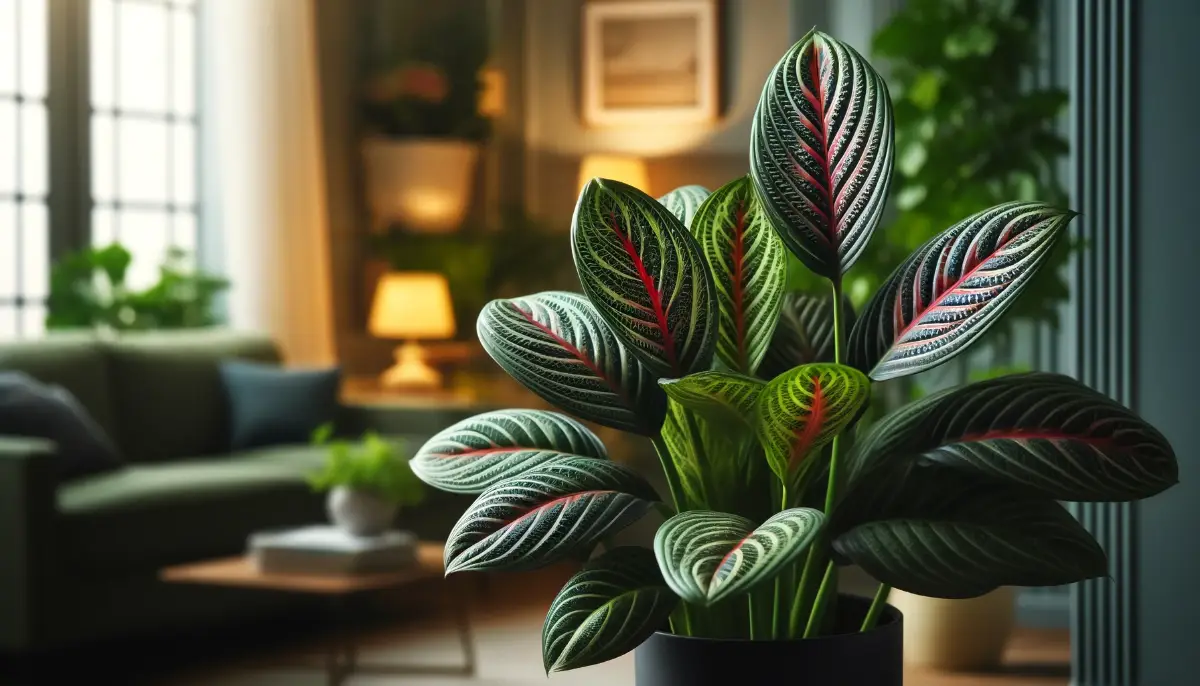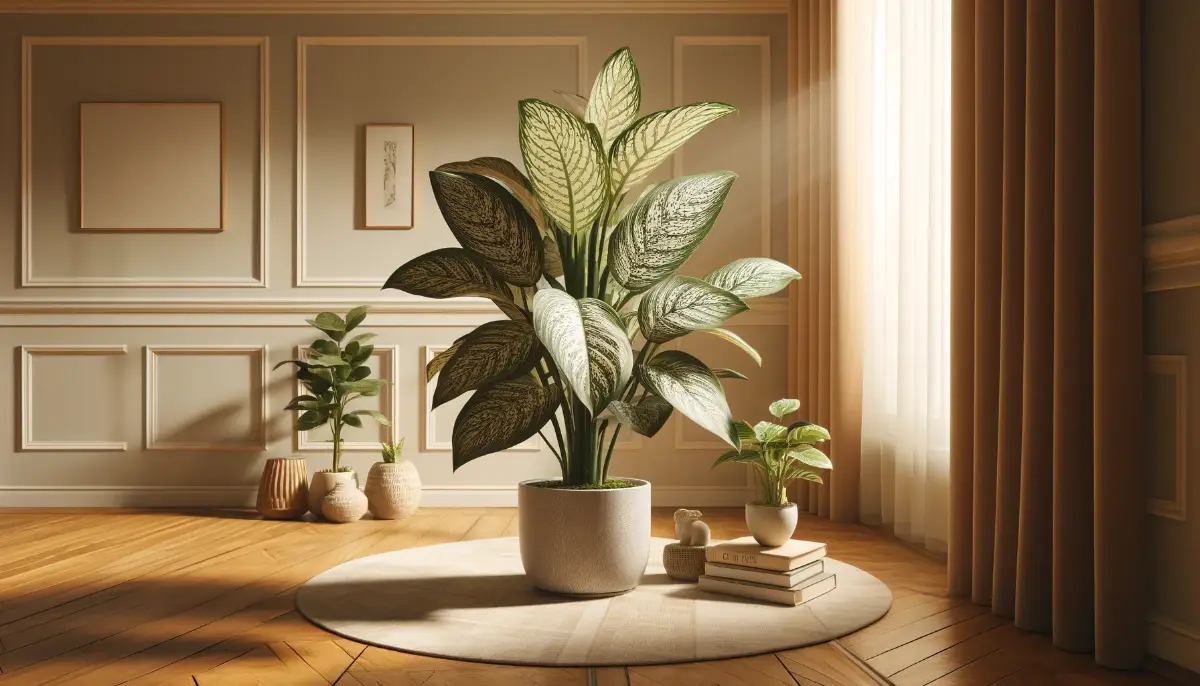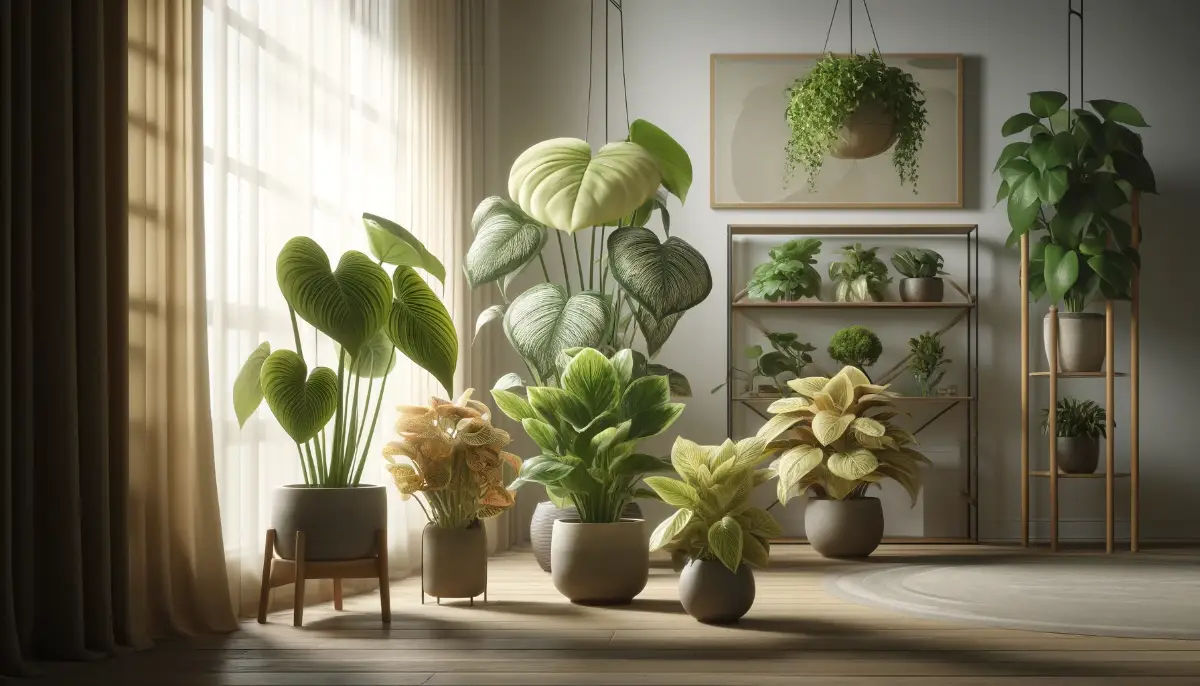The Maranta leuconeura, commonly known as the Prayer Plant, is a popular houseplant known for its stunning foliage and unique behavior. The plant gets its name from the way its leaves fold up at night, resembling praying hands.
Native to the tropical regions of Central and South America, particularly Brazil, the Prayer Plant is admired for its oval, dark green leaves adorned with striking patterns of light green, red, and purple.
Growing a Prayer Plant at home not only enhances indoor aesthetics but also contributes to a healthier living environment by improving air quality. Its low maintenance requirements and adaptability make it an excellent choice for both novice and experienced plant enthusiasts.
Selecting the Right Environment
Creating the ideal environment for your Maranta leuconeura is crucial to ensure its health and growth. Here’s how to select and prepare the right spot in your home for this beautiful Prayer Plant:
Ideal Location in the Home
- Placement: Choose a location that receives bright, indirect light. Direct sunlight can scorch the leaves, while too little light can lead to leggy growth.
- Room Choice: Bathrooms, kitchens, and living rooms with east or north-facing windows are often ideal as they offer the right balance of light and humidity.
Light Requirements
- Indirect Light: The Prayer Plant thrives in bright, indirect light. It can tolerate low light conditions but will grow best in a spot that receives filtered sunlight.
- Artificial Lighting: If natural light is insufficient, consider using fluorescent or LED grow lights to provide the necessary light levels.
Temperature and Humidity Needs
- Temperature: Maintain a consistent temperature between 65-75°F (18-24°C). Avoid placing the plant near drafts, air conditioning vents, or heaters, as sudden temperature changes can stress the plant.
- Humidity: Maranta leuconeura prefers high humidity levels, ideally between 60-80%. Homes with naturally high humidity or areas where you can easily increase humidity (like bathrooms) are ideal.
Humidity Tips:
- Use a room humidifier to maintain optimal humidity levels.
- Place a tray filled with water and pebbles beneath the plant’s pot. As the water evaporates, it will increase the humidity around the plant.
- Grouping plants together can also help create a more humid microenvironment.
By carefully selecting and preparing the right environment for your Prayer Plant, you can create a thriving habitat that promotes healthy growth and vibrant foliage.
Planting and Potting
Proper planting and potting techniques are essential for the healthy growth of your Maranta leuconeura (Prayer Plant). Here’s a detailed guide to help you get started:
Choosing the Right Pot
- Size: Select a pot that is slightly larger than the root ball of your plant. A pot that is too large can lead to overwatering and root rot.
- Material: Terra cotta or ceramic pots with drainage holes are ideal as they allow excess water to escape and provide good air circulation to the roots.
- Drainage: Ensure the pot has adequate drainage holes to prevent water from accumulating at the bottom, which can cause root rot.
Soil Requirements
- Well-Draining Mix: Use a high-quality, well-draining potting mix. A mixture of peat, perlite, and potting soil is ideal. You can also add a small amount of sand to improve drainage.
- Moisture Retention: The soil should retain some moisture but not stay soggy. A mix designed for African violets or tropical plants can work well.
Initial Planting Steps
Preparation:
- Place a layer of gravel or small stones at the bottom of the pot to improve drainage.
- Partially fill the pot with the potting mix.
Planting:
- Gently remove the Prayer Plant from its current container, being careful not to damage the roots.
- Place the plant in the new pot, positioning it so that the root ball is centered and the top of the root ball is about an inch below the rim of the pot.
- Fill in around the root ball with the potting mix, pressing gently to eliminate air pockets.
Watering:
- After planting, water the plant thoroughly to help settle the soil. Ensure that excess water drains out from the bottom of the pot.
- Allow the top inch of soil to dry out before watering again to prevent overwatering.
By following these steps, you can ensure that your Maranta leuconeura is properly planted and potted, providing a solid foundation for its growth and development.
Watering and Humidity
Proper watering and maintaining high humidity are crucial for the health and growth of your Maranta leuconeura (Prayer Plant). Here’s how to ensure your plant receives the right amount of water and humidity:
Proper Watering Techniques
- Water Quality: Use distilled or filtered water, or let tap water sit out overnight to allow chlorine to evaporate. Prayer Plants are sensitive to chemicals in tap water.
- Watering Method: Water the plant thoroughly until water runs out of the drainage holes. This ensures the roots are well-hydrated.
- Watering Frequency: Water when the top inch of soil feels dry to the touch. Depending on the indoor climate, this may be every 1-2 weeks. Adjust based on the plant’s needs and the season.
Frequency of Watering
- Regular Checks: Check soil moisture regularly to avoid both overwatering and underwatering. The soil should be kept consistently moist but not soggy.
- Seasonal Adjustments: During the growing season (spring and summer), the plant may require more frequent watering. In fall and winter, reduce the frequency as the plant’s growth slows down.
Importance of High Humidity
- Preferred Humidity Levels: The Prayer Plant thrives in high humidity environments, ideally between 60-80%. Low humidity can cause the leaves to curl or develop brown edges.
- Humidity Indicators: Brown leaf tips or edges and wilting are signs that the plant needs more humidity.
Tips for Maintaining Humidity
- Misting: Lightly mist the leaves with water every few days to increase humidity. Use distilled or filtered water to avoid mineral buildup on the leaves.
- Humidifier: Use a room humidifier to maintain a consistent level of humidity around the plant, especially during dry winter months.
- Pebble Tray: Place a tray filled with water and pebbles beneath the plant’s pot. As the water evaporates, it will increase the humidity around the plant.
- Grouping Plants: Group your Prayer Plant with other humidity-loving plants. This can create a microenvironment with higher humidity.
- Bathroom Placement: Placing the plant in a bathroom can be beneficial due to the naturally higher humidity levels.
By following these guidelines for watering and maintaining humidity, you can create an ideal environment for your Maranta leuconeura, ensuring it remains healthy and vibrant.
Organic Feeding and Fertilization
Proper feeding and fertilization are essential for the healthy growth and vibrant foliage of your Maranta leuconeura (Prayer Plant). Using organic methods ensures that the plant receives the necessary nutrients in an eco-friendly and sustainable way. Here’s how to feed and fertilize your Prayer Plant organically:
Type of Organic Fertilizer to Use
- Compost: Rich in nutrients, compost can be mixed into the soil to improve its quality and provide a slow-release source of nourishment.
- Worm Castings: Worm castings are an excellent organic fertilizer that boosts soil fertility and promotes healthy root development.
- Liquid Seaweed/Kelp Extract: This is a great organic fertilizer that can be diluted and used as a foliar spray or soil drench. It provides trace minerals and promotes overall plant health.
- Fish Emulsion: A balanced, nitrogen-rich organic fertilizer that promotes lush foliage growth. It should be diluted before application.
Frequency and Method of Fertilizing
- Growing Season: Fertilize the Prayer Plant every 2-4 weeks during the growing season (spring and summer). This is when the plant is actively growing and requires more nutrients.
- Dormant Season: Reduce fertilization frequency during fall and winter to once every 6-8 weeks, as the plant’s growth slows down.
Application Method:
- Soil Drench: Dilute the liquid organic fertilizer according to the manufacturer’s instructions and water the plant with this solution. Ensure the soil is evenly moist after application.
- Foliar Feeding: Spray diluted liquid seaweed or kelp extract directly onto the leaves, ensuring even coverage. This allows the plant to absorb nutrients directly through its foliage.
- Top Dressing: Apply a thin layer of compost or worm castings to the top of the soil. Water thoroughly after application to help nutrients reach the root zone.
Tips for Effective Fertilization
- Dilution: Always dilute liquid organic fertilizers to avoid nutrient burn and ensure gentle feeding.
- Consistency: Stick to a regular fertilization schedule, but avoid over-fertilizing, which can harm the plant.
- Observation: Monitor the plant for signs of nutrient deficiencies or excesses. Yellowing leaves, stunted growth, or leaf drop can indicate a need to adjust fertilization practices.
- Balance: Ensure a balanced nutrient supply by using a combination of different organic fertilizers. This helps provide a wide range of essential nutrients.
By using organic feeding and fertilization methods, you can ensure that your Maranta leuconeura receives the necessary nutrients in a sustainable and environmentally friendly manner. This promotes healthy growth, vibrant foliage, and long-term plant health.
Pruning and Maintenance
Regular pruning and maintenance are essential for keeping your Maranta leuconeura (Prayer Plant) healthy, vibrant, and well-shaped. Here’s a guide to help you with effective pruning and ongoing care:
How to Prune and Shape the Plant
- Timing: The best time to prune your Prayer Plant is during the growing season (spring and summer) when the plant is actively growing.
- Tools: Use sharp, sterilized scissors or pruning shears to make clean cuts and prevent disease.
Pruning Steps:
Identify Dead or Damaged Leaves: Look for yellow, brown, or wilted leaves. These should be removed to encourage new growth and maintain the plant’s appearance.
Trim Leggy Growth: If the plant becomes leggy (with long, sparse stems), trim back these stems to encourage fuller, bushier growth.
Shape the Plant: Cut back stems that disrupt the desired shape of the plant. Make your cuts just above a leaf node (where leaves attach to the stem) to encourage new growth from that point.
Remove Old Leaves: Periodically remove older leaves that are naturally dying off to make room for new growth.
Removing Dead or Yellowing Leaves
- Routine Checks: Regularly inspect the plant for dead or yellowing leaves. Removing these promptly helps prevent potential pest and disease issues.
- Removal Technique: Gently pull or cut the leaves close to the base, being careful not to damage the healthy parts of the plant.
Tips for Keeping the Plant Healthy and Vibrant
Cleaning the Leaves: Dust can accumulate on the leaves, hindering photosynthesis. Wipe the leaves with a damp cloth to keep them clean and shiny.
Rotate the Plant: Rotate the plant periodically to ensure even light exposure and promote balanced growth.
Monitor for Pests: Regularly check for common pests such as spider mites, aphids, and mealybugs. If pests are detected, treat them promptly with organic insecticidal soap or neem oil.
Maintain Humidity: Consistently maintain high humidity levels, as the Prayer Plant thrives in humid environments. Use a humidifier, mist the plant, or place it on a pebble tray with water.
Proper Watering: Ensure consistent moisture in the soil without overwatering. Adjust watering frequency based on the season and indoor climate.
Fertilization: Continue to feed the plant with organic fertilizers as outlined in the feeding and fertilization section, ensuring it receives the necessary nutrients for healthy growth.
Check for Root Bound: Periodically check if the plant is becoming root-bound (roots growing out of the drainage holes). If necessary, repot the plant into a slightly larger pot to encourage healthy root growth.
Propagation
Propagating your Maranta leuconeura (Prayer Plant) allows you to create new plants from an existing one, making it a cost-effective way to expand your collection or share with others. Here’s a step-by-step guide to propagating your Prayer Plant:
Methods of Propagation
- Stem Cuttings: One of the most common and effective methods for propagating Prayer Plants.
- Division: This method involves separating the plant into smaller sections, each with its own root system.
Step-by-Step Guide to Propagating the Plant
Stem Cuttings
Selecting a Cutting:
- Choose a healthy stem with at least two to three leaves and a few nodes (the points where leaves attach to the stem).
- Make sure the stem is free from any pests or diseases.
Preparing the Cutting:
- Using a sharp, sterilized knife or scissors, cut the stem just below a node.
- Remove the lower leaves, leaving at least one or two leaves at the top of the cutting.
Rooting the Cutting in Water:
- Place the cutting in a glass of water, ensuring that at least one node is submerged.
- Position the glass in a location with bright, indirect light.
- Change the water every few days to keep it fresh and prevent stagnation.
- Roots should start to develop in a few weeks. Once the roots are a few inches long, the cutting is ready to be planted in soil.
Planting the Cutting:
- Prepare a small pot with a well-draining potting mix.
- Make a hole in the soil and gently place the rooted cutting into the hole, covering the roots with soil.
- Water the soil thoroughly and keep it consistently moist.
Division
Preparing the Plant:
- Carefully remove the Prayer Plant from its pot, being gentle with the roots to avoid damage.
- Gently shake off excess soil to expose the root system.
Dividing the Plant:
- Look for natural divisions in the root system where the plant can be separated into smaller sections.
- Using your hands or a sharp, sterilized knife, separate the plant into sections, ensuring each section has roots and a few leaves.
Planting the Divisions:
- Prepare new pots with a well-draining potting mix.
- Plant each division in its own pot, covering the roots with soil and pressing gently to secure the plant.
- Water each newly potted plant thoroughly.
Care Tips for Newly Propagated Plants
- Light: Place the newly propagated plants in a location with bright, indirect light to help them establish and grow.
- Humidity: Maintain high humidity by misting the plants or using a humidifier, as newly propagated plants are more susceptible to drying out.
- Watering: Keep the soil consistently moist but not soggy. Be careful not to overwater, as young roots are more prone to rot.
- Monitoring: Regularly check the new plants for signs of stress or pest issues, addressing any problems promptly to ensure healthy growth.
Dealing with Common Problems
While Maranta leuconeura (Prayer Plant) is relatively easy to care for, it can encounter several common problems. Identifying and addressing these issues promptly will help maintain the plant’s health and beauty. Here’s how to deal with common problems:
Identifying and Treating Pests
Spider Mites: Tiny, red or yellow specks often found on the undersides of leaves; webs may be visible.
- Treatment: Wipe leaves with a damp cloth and spray with a mixture of water and neem oil or insecticidal soap. Increase humidity as spider mites thrive in dry conditions.
Mealybugs: White, cotton-like masses on leaves and stems.
- Treatment: Dab mealybugs with a cotton swab dipped in rubbing alcohol. Follow up with an insecticidal soap spray.
Aphids: Small, green or black insects clustering on new growth.
- Treatment: Spray the plant with water to dislodge aphids and apply insecticidal soap or neem oil.
Recognizing Signs of Overwatering or Underwatering
Overwatering:
- Signs: Yellowing leaves, mushy stems, and root rot.
- Solution: Allow the soil to dry out before watering again. Ensure the pot has adequate drainage and consider repotting in fresh, well-draining soil if root rot is severe.
Underwatering:
- Signs: Brown leaf edges, curling leaves, and dry soil.
- Solution: Water the plant thoroughly, ensuring that water reaches the roots. Increase the frequency of watering, but avoid waterlogging the soil.
Addressing Leaf Issues
Curling Leaves:
- Cause: Low humidity, underwatering, or sudden temperature changes.
- Solution: Increase humidity by misting the plant, using a humidifier, or placing the plant on a pebble tray with water. Ensure consistent watering and stable temperatures.
Browning Edges:
- Cause: Low humidity, over-fertilization, or underwatering.
- Solution: Increase humidity, reduce the amount of fertilizer, and ensure consistent watering. Flush the soil with water if over-fertilization is suspected.
Yellowing Leaves:
- Cause: Overwatering, poor drainage, or lack of nutrients.
- Solution: Allow the soil to dry between waterings, improve drainage, and consider feeding the plant with a balanced, organic fertilizer.
General Care Tips to Prevent Problems
Light: Ensure the plant receives bright, indirect light. Avoid direct sunlight, which can scorch the leaves.
Soil: Use a well-draining potting mix to prevent waterlogging and root rot.
Air Circulation: Provide good air circulation around the plant to prevent fungal issues. Avoid placing the plant in drafty areas.
Cleaning: Regularly clean the leaves to remove dust and prevent pest infestations. Use a damp cloth to gently wipe the leaves.
Regular Monitoring: Frequently check the plant for any signs of pests, diseases, or other issues. Early detection and intervention are key to maintaining plant health.
FAQs about Maranta leuconeura (Prayer Plant)
How often should I water my Prayer Plant?
Water your Prayer Plant when the top inch of soil feels dry. This typically means watering every 1-2 weeks, but frequency can vary based on the indoor climate and season. Ensure the soil remains consistently moist but not waterlogged.
What type of light is best for a Prayer Plant?
Prayer Plants thrive in bright, indirect light. Direct sunlight can scorch their leaves, while too little light can lead to leggy growth. East or north-facing windows are ideal.
How can I increase humidity for my Prayer Plant?
Increase humidity by misting the plant regularly, using a humidifier, or placing the plant on a pebble tray with water. Grouping plants together can also create a more humid microenvironment.
Why are the leaves of my Prayer Plant curling?
Curling leaves can be a sign of low humidity, underwatering, or sudden temperature changes. Ensure consistent moisture, maintain high humidity, and avoid placing the plant in drafty areas.
What should I do if my Prayer Plant has yellowing leaves?
Yellowing leaves can indicate overwatering, poor drainage, or nutrient deficiencies. Allow the soil to dry between waterings, improve drainage, and consider feeding the plant with a balanced, organic fertilizer.
How do I propagate my Prayer Plant?
You can propagate your Prayer Plant through stem cuttings or division. For stem cuttings, place cuttings in water until roots develop, then plant in soil. For division, separate the plant into sections, ensuring each has roots and leaves, and plant each section in its own pot.
What pests commonly affect Prayer Plants and how can I treat them?
Common pests include spider mites, mealybugs, and aphids. Treat these pests by wiping leaves with a damp cloth, using insecticidal soap, or applying neem oil. Increase humidity to deter spider mites.
Can I use tap water for my Prayer Plant?
Prayer Plants are sensitive to chemicals in tap water, such as chlorine and fluoride. Use distilled or filtered water, or let tap water sit out overnight to allow chlorine to evaporate before using it.
How often should I fertilize my Prayer Plant?
Fertilize your Prayer Plant every 2-4 weeks during the growing season (spring and summer) with an organic fertilizer. Reduce fertilization to once every 6-8 weeks during the fall and winter.










